- Details
- Written by: Elmazen
- Category: Flags of Countries of the World
- Hits: 823
Flag of Slovenia, Currency, Population, Tourist Places
Exploring Slovenia: Population, Flag Meaning, Currency, Borders, Culture, and Must-Visit Places
Slovenia, a small yet incredibly beautiful country in Central Europe, has captured the hearts of travelers with its stunning landscapes, rich culture, and vibrant history.
Here’s a closer look at some essential aspects of Slovenia:
Flag of Slovenia, Currency, Population, Tourist Places
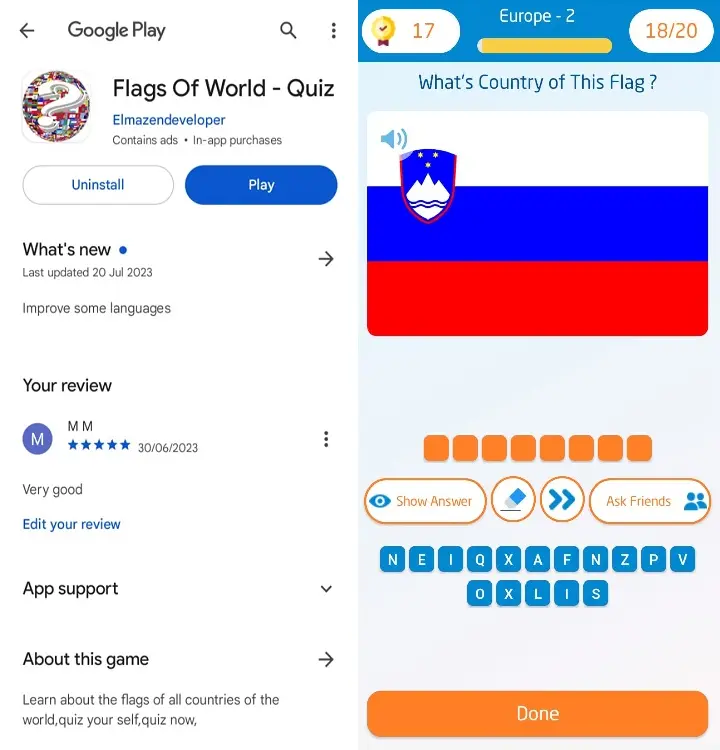
Download the application  Flags Of World - Quiz ,
Flags Of World - Quiz ,
And test your knowledge with Flags of World ,
1. Population of Slovenia :
As of December 2024, Slovenia has a population of around 2.117 million people.
The population is relatively small, making Slovenia a peaceful and cozy destination where travelers can enjoy its natural beauty and unique culture without overwhelming crowds.
2. Meaning of Slovenia’s Flag :
Slovenia’s flag consists of three horizontal stripes: white on top, blue in the middle, and red at the bottom.
In the top left corner of the flag, there is Slovenia's coat of arms, which features:
The Three Peaks of Mount Triglav : The tallest mountain in Slovenia and a national symbol.
Wavy Lines : Representing Slovenia’s rivers and the Adriatic Sea.
Three Six-Pointed Stars : These are taken from the coat of arms of the Counts of Celje, a powerful medieval dynasty that played a significant role in Slovenia’s history.
Together, the colors and symbols embody Slovenia’s natural landscape and historical heritage.
3. Slovenia’s Currency :
Slovenia adopted the Euro (€) as its official currency in 2007 when it joined the Eurozone.
Prior to that, Slovenia used the Slovenian tolar (SIT).
The adoption of the Euro made travel and trade easier within the European Union, which Slovenia has been a member of since 2004.
Flag of Slovenia, Currency, Population, Tourist Places

Download the application  Flags Of World - Quiz ,
Flags Of World - Quiz ,
And test your knowledge with Flags of World ,
4. Borders of Slovenia :
Slovenia shares borders with four countries:
Italy : to the west,
Austria : to the north,
Hungary : to the northeast,
Croatia : to the south and southeast.
Slovenia also has a small coastline along the Adriatic Sea, providing access to maritime trade and beautiful seaside destinations.
5. Culture of Slovenia :
Slovenian culture is a blend of Slavic, Germanic, and Mediterranean influences.
Key cultural highlights include:
Language : Slovenian (or Slovene) is the official language and is unique as it retains grammatical forms that other Slavic languages have lost.
Festivals : Slovenia celebrates many traditional festivals, such as Kurentovanje, a carnival event held in Ptuj where people dress in colorful masks to ward off winter.
Cuisine : Slovenian food is hearty and diverse, reflecting Central European and Mediterranean influences.
Popular dishes include potica (a rolled pastry), žlikrofi (dumplings), and kranjska klobasa (Carniolan sausage).
Art and Music : Folk music and dance are an important part of Slovenian identity.
Traditional costumes are still worn during festivals, and folk songs are performed with traditional instruments like the accordion.
6. Best Places to Visit in Slovenia :
Slovenia is full of breathtaking spots that attract visitors from around the world.
Here are some of the must-visit places:
Lake Bled :
With its picturesque island and medieval castle overlooking the lake, Lake Bled is one of Slovenia's most iconic sites.
Ljubljana :
The charming capital city is known for its vibrant old town, riverside cafes, and the iconic Ljubljana Castle.
Triglav National Park :
Named after Slovenia’s highest mountain, this park offers hiking, stunning alpine views, and a variety of outdoor activities.
Postojna Cave :
A spectacular cave system that visitors can explore by train, known for its impressive stalactites and stalagmites.
Piran :
Located on the Adriatic coast, Piran is a picturesque seaside town with Venetian-style architecture and stunning coastal views.
Soča Valley :
Famous for the turquoise Soča River, this valley offers rafting, fishing, and breathtaking scenery.
Slovenia’s combination of natural beauty, cultural depth, and historic charm makes it a fascinating destination for anyone interested in experiencing a unique European country.
Whether you're a nature lover, history enthusiast, or culinary explorer, Slovenia offers something unforgettable for every traveler.
Flag of Slovenia, Currency, Population, Tourist Places

Download the application  Flags Of World - Quiz ,
Flags Of World - Quiz ,
And test your knowledge with Flags of World ,
- Details
- Written by: Elmazen
- Category: Flags of Countries of the World
- Hits: 801
Flag of Slovakia, Currency, Population, Tourist Places
Discovering Slovakia: A Guide to Population, Flag, Currency, Borders, Culture, and Must-Visit Places
Slovakia, located in Central Europe, is a country with a rich history, vibrant culture, and stunning natural beauty.
Known for its picturesque landscapes, medieval towns, and architectural treasures, Slovakia offers a unique blend of tradition and modernity.
Here’s an overview to you learn more about Slovakia’s population, flag, currency, borders, culture, and top travel destinations.
Flag of Slovakia, Currency, Population, Tourist Places
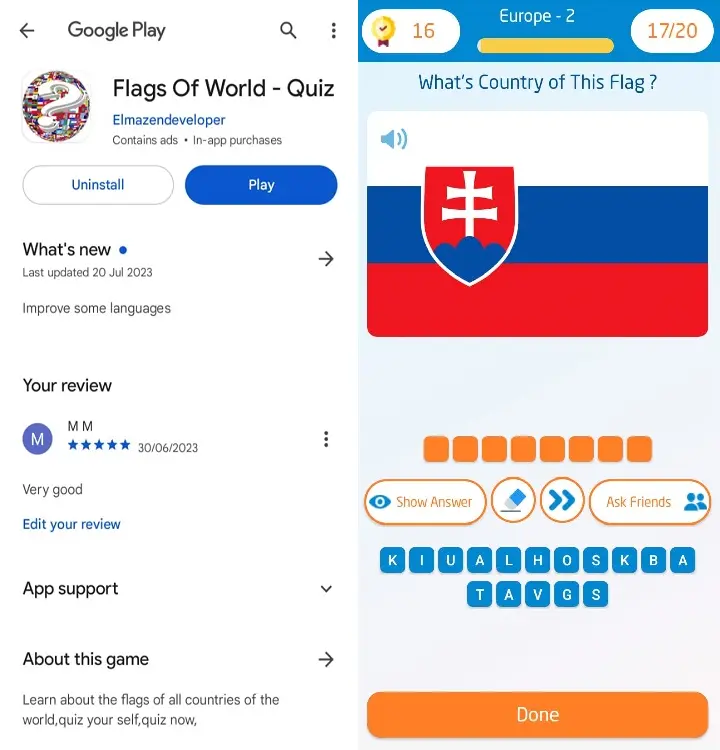
Download the application  Flags Of World - Quiz ,
Flags Of World - Quiz ,
And test your knowledge with Flags of World ,
1. Population of Slovakia :
As of December 2024, Slovakia has a population of around 5.5 million people.
The majority of Slovakia’s population is ethnically Slovak, with minorities that include Hungarians, Czechs, and Romani.
The population is concentrated in major cities such as Bratislava, the capital, and Košice, but a significant portion of Slovaks live in rural areas, where traditional customs are still strong.
2. Slovakia’s Flag and Its Meaning :
The Slovak flag consists of three horizontal stripes in white, blue, and red, with the national coat of arms located on the left side.
The colors of the flag-white, blue, and red-represent the Slavic heritage of Slovakia, shared with other Slavic nations.
The coat of arms is a red shield with a double silver cross that symbolizes Slovakia's Christian heritage, standing on three blue hills that represent the Tatra, Fatra, and Matra mountain ranges, which are culturally significant and geographically distinct in Slovakia.
3. Slovakia’s Currency :
The official currency of Slovakia is the euro (€), symbolized by EUR.
Slovakia adopted the euro in 2009, joining the Eurozone and replacing its former currency, the Slovak koruna.
As a Eurozone member, Slovakia benefits from economic stability and facilitates easier trade and travel within Europe.
Flag of Slovakia, Currency, Population, Tourist Places

Download the application  Flags Of World - Quiz ,
Flags Of World - Quiz ,
And test your knowledge with Flags of World ,
4. Borders of Slovakia :
Slovakia is a landlocked country, sharing borders with five countries:
Austria : to the west,
Czech Republic : to the northwest,
Poland : to the north,
Ukraine : to the east,
Hungary : to the south.
Its central location in Europe makes Slovakia a strategic and accessible destination for travelers exploring the region.
5. Culture of Slovakia :
Slovakia boasts a rich cultural heritage influenced by its history and position in Central Europe.
Slovak culture is known for:
Folk Traditions : Slovakia has a vibrant folk culture with distinctive music, dance, and clothing.
Traditional dances, such as the polka and czardas, and folk music played on the fujara (a large, flute-like instrument) are integral to Slovak festivals.
Festivals and Celebrations : Traditional festivals, like Fašiangy (carnival season), and folk festivals, such as the Východná Folklore Festival, showcase Slovak customs.
Architecture : Slovakia is dotted with castles, medieval towns, and churches, with Bratislava Castle and Spiš Castle being prominent examples.
Cuisine : Slovak food is hearty and often includes ingredients like potatoes, pork, and dairy.
Popular dishes include bryndzové halušky (potato dumplings with sheep cheese), kapustnica (cabbage soup), and goulash.
6. Best Places to Visit in Slovakia :
Slovakia has numerous destinations worth exploring.
Here are some highlights:
Bratislava :
The capital city offers a mix of historic and modern attractions.
Bratislava Castle, Old Town, and the Danube River are must-visit sites.
High Tatras :
Known as the “Slovak Alps,” this mountain range is famous for its stunning peaks, hiking trails, and ski resorts.
The town of Štrbské Pleso is a popular spot within the Tatras.
Spiš Castle :
One of the largest castles in Europe and a UNESCO World Heritage site, Spiš Castle dates back to the 12th century and offers a fascinating glimpse into medieval Slovakia.
Banská Štiavnica :
This historic mining town is known for its charming old town, rich history, and scenic beauty.
It is also a UNESCO World Heritage site.
Košice :
Slovakia's second-largest city, Košice has a well-preserved medieval center, the stunning St. Elisabeth Cathedral, and vibrant arts and culture scenes.
Orava Castle :
One of the most beautiful castles in Slovakia, perched on a hilltop and resembling something from a fairy tale, Orava Castle is popular for historical tours and scenic views.
Slovak Paradise National Park :
Known for its natural beauty, waterfalls, and hiking trails, this national park offers an adventurous outdoor experience with canyons, gorges, and unique rock formations.
Conclusion :
Slovakia is a hidden gem in Central Europe, blending scenic landscapes, historical architecture, and deep-rooted traditions.
Whether you’re captivated by its castles, intrigued by its folk culture, or eager to explore its mountains, Slovakia offers a travel experience that’s both enriching and memorable.
Flag of Slovakia, Currency, Population, Tourist Places

Download the application  Flags Of World - Quiz ,
Flags Of World - Quiz ,
And test your knowledge with Flags of World ,
- Details
- Written by: Elmazen
- Category: Flags of Countries of the World
- Hits: 831
Flag of Serbia, Currency, Population, Tourist Places
Main aspects of Serbia, including population, flag meaning, currency, borders, culture, and top travel destinations.
Serbia : A Detailed Overview
Flag of Serbia, Currency, Population, Tourist Places
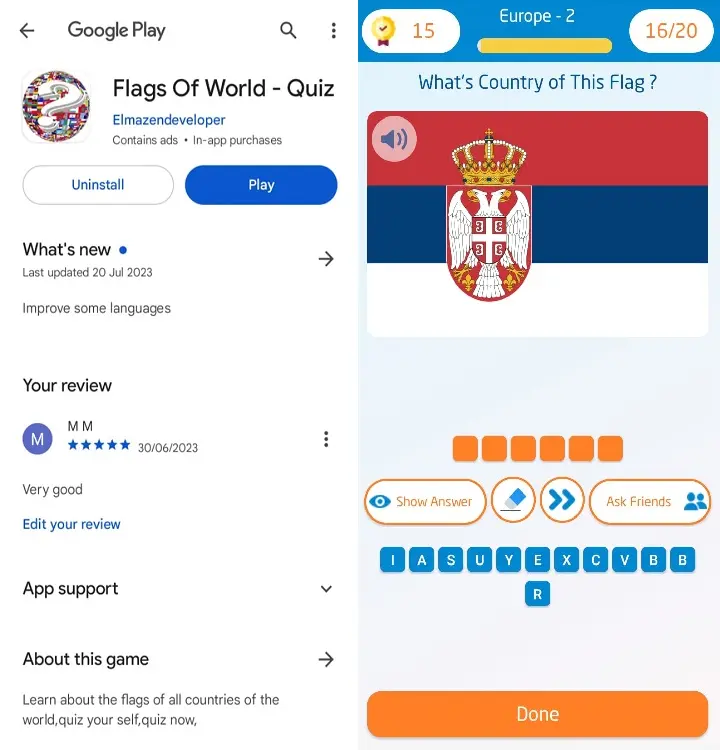
Download the application  Flags Of World - Quiz ,
Flags Of World - Quiz ,
And test your knowledge with Flags of World ,
1. Population of Serbia :
As of December 2024, Serbia has a population of approximately 6.71 million people.
Most of the population resides in urban areas, with Belgrade, the capital, being the largest and most densely populated city.
Serbia’s population is diverse, with Serbs making up the majority, followed by other ethnic groups such as Hungarians, Bosniaks, and Romani.
2. Meaning of Serbia's Flag :
The Serbian flag consists of three horizontal stripes: red on top, blue in the middle, and white at the bottom, with the Serbian coat of arms displayed on the left side.
The colors and design are inspired by the Pan-Slavic colors, symbolizing unity and solidarity among Slavic nations.
The red represents the blood of the Serbian people who fought for independence, blue signifies freedom, and white represents purity and peace.
The coat of arms, featuring a double-headed eagle, is a historical symbol of the Serbian state.
3. Currency of Serbia :
The official currency of Serbia is the Serbian dinar, abbreviated as RSD (din).
Banknotes and coins are issued by the National Bank of Serbia, with various denominations used in daily transactions.
Flag of Serbia, Currency, Population, Tourist Places

Download the application  Flags Of World - Quiz ,
Flags Of World - Quiz ,
And test your knowledge with Flags of World ,
4. Borders of Serbia :
Serbia is a landlocked country in Southeastern Europe, situated in the Balkan Peninsula.
It shares borders with eight countries: Hungary to the north, Romania to the northeast, Bulgaria to the southeast, North Macedonia to the south, Montenegro to the southwest, Bosnia and Herzegovina to the west, Croatia to the northwest, and an administrative boundary with Kosovo to the south.
5. Culture of Serbia :
Serbian culture is rich in traditions and is shaped by both Eastern and Western influences.
This blend is evident in various aspects of life, from its cuisine, which includes dishes like ćevapi, sarma, and burek, to its music and folklore.
Orthodox Christianity plays a central role, with traditional celebrations such as Slava, a unique family holiday honoring the family’s patron saint.
Music and folk dances, particularly the traditional kolo dance, are also integral to Serbian celebrations.
Additionally, Serbia is known for its vibrant festivals, such as the EXIT music festival in Novi Sad and the Guča Trumpet Festival.
6. Best Places to Visit in Serbia :
Belgrade :
The capital city, known for its nightlife, historic Kalemegdan Fortress, and vibrant streets like Knez Mihailova.
Novi Sad :
A cultural hub with the famous Petrovaradin Fortress, which hosts the EXIT Festival annually.
Niš :
One of the oldest cities in Europe, rich in Roman history and home to Niš Fortress and the Skull Tower.
Tara National Park :
Known for its stunning landscapes, hiking trails, and the breathtaking Drina River Canyon.
Studenica Monastery :
A UNESCO World Heritage Site, this monastery is an architectural marvel and a significant religious site.
Drvengrad (Mokra Gora) :
A unique wooden village created by Serbian filmmaker Emir Kusturica, known for its traditional architecture and film festival.
Vrnjačka Banja :
A popular spa town known for its mineral springs and beautiful parks.
Serbia offers a mix of historic sites, natural beauty, and a lively cultural scene, making it a fascinating destination for anyone looking to explore Southeastern Europe.
Whether you're interested in history, nature, or vibrant city life, Serbia has something to offer every traveler.
Flag of Serbia, Currency, Population, Tourist Places

Download the application  Flags Of World - Quiz ,
Flags Of World - Quiz ,
And test your knowledge with Flags of World ,
- Details
- Written by: Elmazen
- Category: Flags of Countries of the World
- Hits: 794
Flag of San Marino, Currency, Population, Tourist Places
Explore : Flag of San Marino, Currency, Population, Tourist Places, Borders, Culture
San Marino: The Enchanting Microstate
San Marino, a small yet remarkable nation nestled on the Italian Peninsula, is one of the world’s oldest republics.
Despite its size, this microstate captivates visitors with its rich culture, beautiful landscapes, and intriguing history.
Here’s a closer look at the essential aspects of San Marino.
Flag of San Marino, Currency, Population, Tourist Places
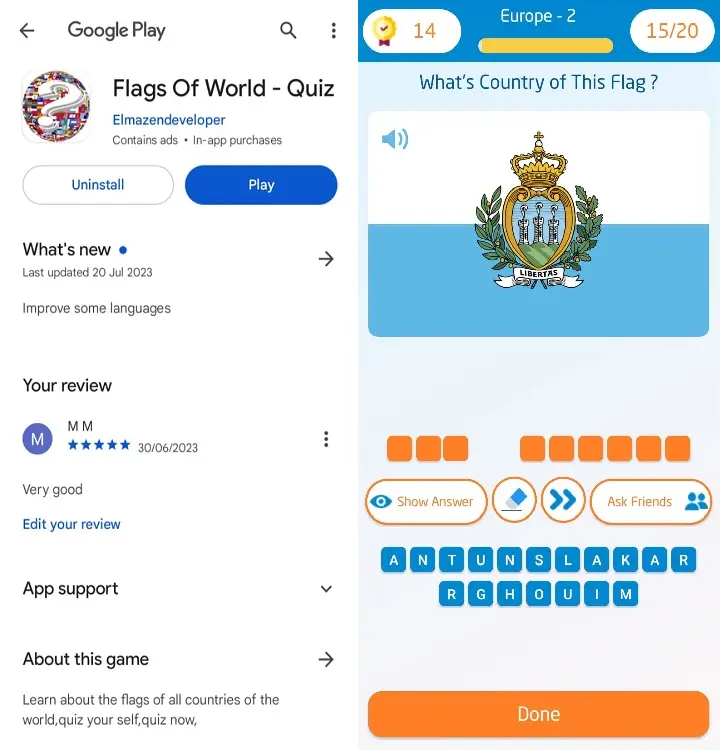
Download the application  Flags Of World - Quiz ,
Flags Of World - Quiz ,
And test your knowledge with Flags of World ,
1. Population of San Marino :
San Marino is one of the world’s least populated countries, with an estimated population of around 33,570 people as of December 2024.
Despite its small population, San Marino maintains a strong sense of community and a vibrant local culture.
Most residents live in urban areas, with the capital city, San Marino, being the most populous.
2. San Marino’s Flag and Its Meaning :
The flag of San Marino is made up of two horizontal bands: white on the top and light blue on the bottom.
The country’s coat of arms sits prominently in the center, which includes three distinctive towers representing the three peaks of Mount Titano.
Each tower is topped with a silver ostrich feather, signifying peace and freedom.
The coat of arms also features a crown representing sovereignty, an oak and laurel wreath symbolizing the country’s endurance and resilience, and the word Libertas (Latin for "Liberty") beneath, which is a fundamental value for San Marino.
3. San Marino’s Currency :
While San Marino is an independent country, it has a customs and monetary agreement with Italy, which allows it to use the euro (€) as its official currency, despite not being part of the European Union.
Previously, it used the Italian lira, and today it issues its own euro coins, which are collectible and often sought after by numismatists.
Flag of San Marino, Currency, Population, Tourist Places

Download the application  Flags Of World - Quiz ,
Flags Of World - Quiz ,
And test your knowledge with Flags of World ,
4. Borders of San Marino :
San Marino is an enclave within Italy, meaning it’s entirely surrounded by Italian territory.
The country covers a mere 61 square kilometers, making it the fifth smallest nation in the world.
Its only neighbor is Italy, sharing a 39-kilometer border along the regions of Emilia-Romagna and Marche.
5. Culture of San Marino :
San Marino’s culture reflects a blend of Italian influences with its own unique traditions.
The country places a high value on art, music, and cuisine.
Italian is the official language, and Catholicism is the dominant religion, although the nation observes freedom of religious practices.
Cultural festivals, such as the Medieval Days, are held annually and feature reenactments, local crafts, and traditional costumes, celebrating the country’s rich medieval heritage.
The country’s history and folklore are expressed through art, music, and theater, which play essential roles in San Marino’s cultural life.
6. Best Places to Visit in San Marino :
Though small in size, San Marino is packed with attractions:
Mount Titano and the Three Towers :
The country’s symbol and UNESCO World Heritage Site, Mount Titano is home to the three towers - Guaita, Cesta, and Montale.
They date back to medieval times and offer panoramic views of the surrounding Italian countryside.
Basilica di San Marino :
Located in the capital, this neoclassical basilica is dedicated to San Marino’s patron saint and founder.
The basilica features beautiful sculptures and a serene atmosphere.
Piazza della Libertà :
The main square in the capital, it’s a gathering place for both locals and tourists.
Here you’ll find the Palazzo Pubblico, San Marino’s town hall and a historic symbol of government.
The square often hosts events, including the changing of the guard ceremony.
Museo di Stato (State Museum) :
Located in the capital, this museum showcases a range of artifacts, including art, coins, and relics from San Marino’s history.
It offers insight into the country’s fascinating heritage.
The Wax Museum :
Featuring over 100 life-sized wax statues of historic figures, this museum is a fun attraction for history enthusiasts.
San Marino’s charm lies in its scenic beauty, cultural richness, and the warmth of its people.
This microstate is a hidden gem that offers a journey through history and a unique European experience.
Flag of San Marino, Currency, Population, Tourist Places

Download the application  Flags Of World - Quiz ,
Flags Of World - Quiz ,
And test your knowledge with Flags of World ,
- Details
- Written by: Elmazen
- Category: Flags of Countries of the World
- Hits: 789
Flag of Romania
Explore : Flag of Romania, Currency, Population, Tourist Places, Borders, Culture
Romania: A Guide to the Heart of Eastern Europe
Romania, located in southeastern Europe, is known for its stunning landscapes, rich history, and vibrant cultural heritage.
Whether you’re drawn by its historical sites, picturesque mountains, or famous folklore, here’s a detailed look into Romania’s population, flag, currency, borders, culture, and best places to visit.
Flag of Romania, Currency, Population, Tourist Places
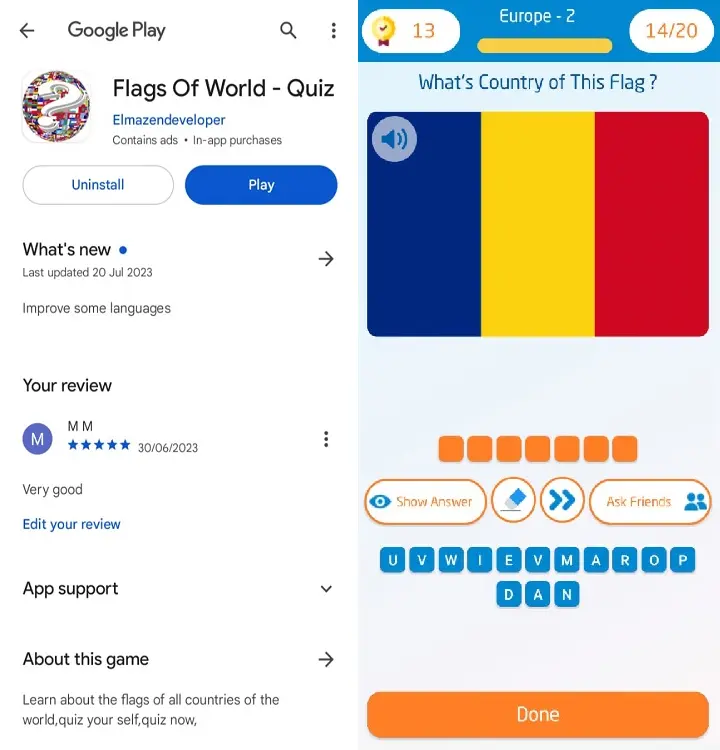
Download the application  Flags Of World - Quiz ,
Flags Of World - Quiz ,
And test your knowledge with Flags of World ,
1. Romania's Population :
Romania has a population of December 2024, approximately 18.96 million people.
This population has seen a slight decline in recent years due to emigration and lower birth rates, but Romania remains one of the more populous countries in southeastern Europe.
The majority of Romanians live in urban areas, with Bucharest, the capital, being the largest city with over 2 million residents.
2. The Romanian Flag and Its Meaning :
Romania's flag consists of three vertical stripes of blue, yellow, and red, in that order from left to right.
Each color holds significant meaning:
Blue : Represents freedom and the open sky,
Yellow : Symbolizes prosperity and the grain fields of the country,
Red : Stands for the blood shed in the struggle for independence and unity,
This tricolor flag is a symbol of national pride and has been in use, in various forms, since the 19th century.
3. Romania's Currency :
The official currency of Romania is the Romanian leu (plural: lei), abbreviated as RON.
Each leu is divided into 100 bani.
The currency name “leu,” which means “lion,” has historical roots dating back to the 17th century when coins depicting a lion circulated in the region.
Flag of Romania, Currency, Population, Tourist Places

Download the application  Flags Of World - Quiz ,
Flags Of World - Quiz ,
And test your knowledge with Flags of World ,
4. Romania’s Borders :
Romania shares its borders with five countries:
Ukraine : to the north,
Moldova : to the east,
Bulgaria : to the south,
Serbia : to the southwest,
Hungary : to the west,
Additionally, Romania has a coastline along the Black Sea to the southeast, giving it maritime access.
5. Culture of Romania :
Romania's culture is a vibrant mix of traditions, folklore, and a unique blend of Eastern and Western influences.
Some key aspects of Romanian culture include:
Folklore and Legends : Romania is famous for its folklore, particularly the story of Dracula, which originates from the historical figure Vlad the Impaler, a 15th-century ruler.
Romanian folktales also feature mythical creatures and deep-rooted superstitions.
Language : Romanian, a Romance language with Latin roots, is closely related to Italian, French, Spanish, and Portuguese.
This Latin heritage connects Romania to Western Europe, despite its geographic location in Eastern Europe.
Music and Dance : Traditional music, with instruments like the violin, accordion, and cobza (a stringed instrument), is highly valued, especially in rural areas.
The "hora," a traditional circle dance, is a popular communal activity.
Religion : Romania is predominantly Orthodox Christian, and religious festivals and customs play a significant role in Romanian culture, particularly around Easter and Christmas.
Cuisine : Romanian cuisine is hearty and features dishes such as sarmale (cabbage rolls stuffed with meat and rice), mămăligă (polenta), and ciorbă (sour soup).
Desserts like cozonac (sweet bread) are often prepared for holidays.
6. Best Places to Visit in Romania :
Romania offers a wealth of sites for travelers.
Here are some must-see destinations:
Bucharest :
The capital city, known as "Little Paris" for its Belle Époque architecture, is home to the monumental Palace of the Parliament and the historic Lipscani district.
Transylvania :
Famed for its connection to Dracula, Transylvania is a region of medieval towns, gothic castles, and beautiful landscapes.
Key attractions include Bran Castle, thought to have inspired the Dracula legend, and the cities of Brașov and Sibiu.
The Carpathian Mountains :
Perfect for hiking, skiing, and exploring nature, these mountains offer scenic beauty and wildlife, particularly in the Bucegi Mountains and Piatra Craiului National Park.
The Danube Delta :
This UNESCO World Heritage site is one of Europe’s most biodiverse areas, ideal for birdwatching and enjoying tranquil waterways.
Maramureș :
Known for its traditional wooden churches and vibrant folk traditions, Maramureș is a rural paradise that preserves centuries-old customs.
Sighișoara :
A medieval town and UNESCO World Heritage site, Sighișoara is known for its well-preserved citadel, cobbled streets, and as the birthplace of Vlad the Impaler.
Constanța and the Black Sea Coast :
A seaside destination where visitors can relax on beaches, visit the historic port city of Constanța, and enjoy the vibrant summer resort life in towns like Mamaia.
In summary, Romania’s allure lies in its combination of natural beauty, deep-rooted cultural traditions, and intriguing history.
With its welcoming people and unique destinations, it’s a country well worth exploring.
Flag of Romania, Currency, Population, Tourist Places
